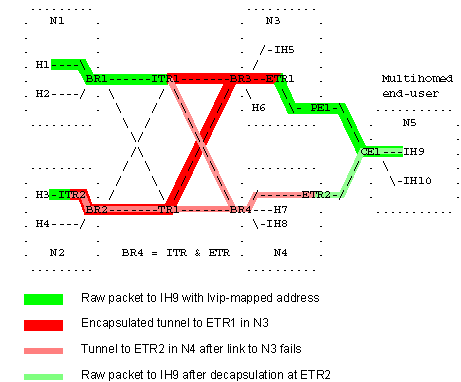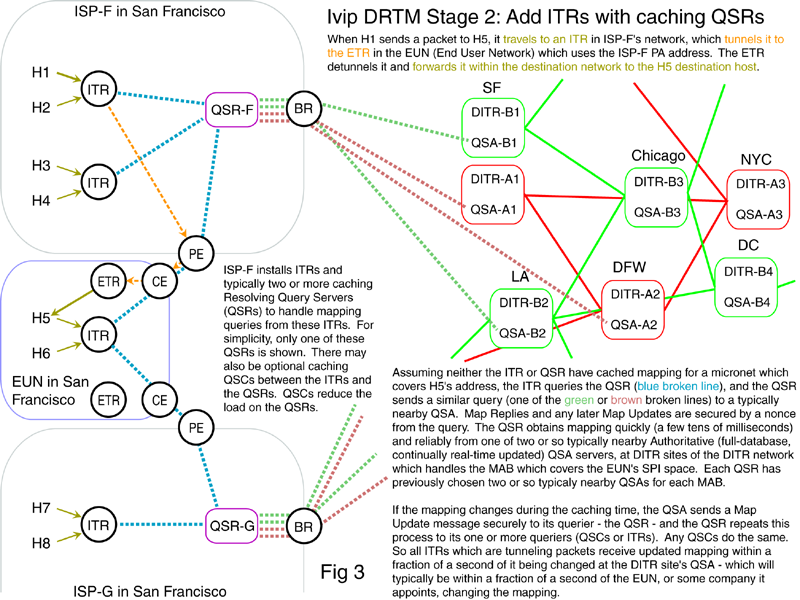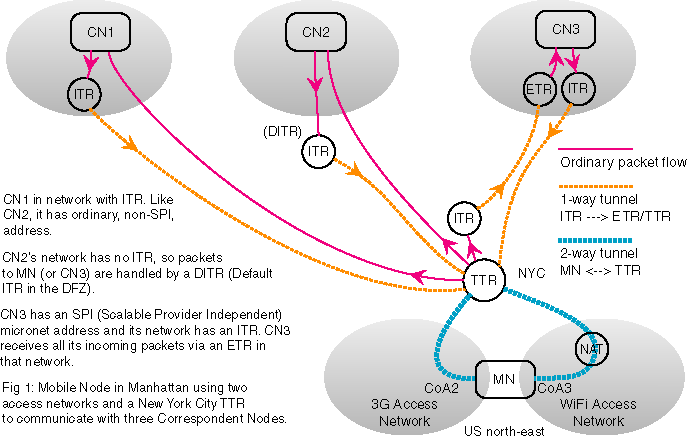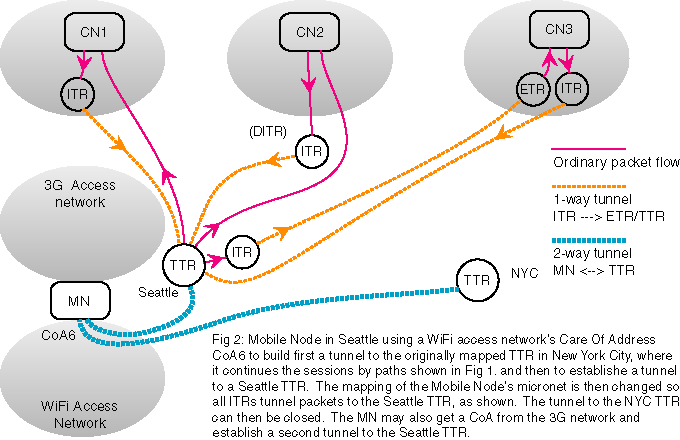 |
 |
| Ivip
- Internet Vastly improved Plumbing
- is intended to help
solve the Internet's routing scaling problem, for both IPv4 and IPv6.
It will also help improve IPv4 address utilization and be a good basis
for the TTR Mobility (below) architecture. I haven't done any work on this since mid-2010, due to the need to focus on paying work. In the future I intend to return to Ivip and TTR Mobility. I have not yet documented two new approaches for getting packets from ITRs to ETRs without conventional encapsulation-based tunneling, using existing packet formats (and so being compatible with all existing routers) and without making the packets any longer. These approaches are related, but different. They are applicable to an ITR-ETR arrangement as used in Ivip, so they are not a magic general form of tunneling. The IPv6 approach is essentially the same as what Finnish wannabe-polymath, libertarian, and all-round nerd Sampo Syreeni http://decoy.iki.fi/ suggested in a personal communication. Inspired by his insights, I thought of a different approach which would be practical for IPv4. None of the Ivip documents below mention these two approaches. Future versions will do so. Ivip could be used just for a non-mobile scalable routing solution. More likely, one or more Ivip-like systems using TTR Mobility could be developed and commercially deployed today, for IPv4 and/or IPv6, for the primary purpose of providing mobility of one or more IPv4 addresses or one or more IPv6 /64 subnets, to mobile devices from hand-held cell-phones to ships or aircraft. In October and November 2011, I am discussing ILNP and the LISP protocol on the main IETF mailing list. I and others also argue that the LISP protocol should be ranamed. See also the pages here on the meaning of "namespace" namespace/ and on why the LISP protocol is not a Locator-Identifier Separation protocol: namespace/lisp-not-loc-id/ . Please note that all references in these pages to "LISP" are to the IETF protocol known as "LISP" and not to the programming language. |
| Scalable
routing has been discussed since early 2007 on the IRTF RRG mailing
list and in RRG meetings. It was also discussed on the IETF RAM
list, and before that, in late 2006, at the RAWS workshop in Amsterdam. Here's my quick intro to Scalable Routing, written in November 2011: The main, or at least original,
purpose of scalable routing is "scalable multihoming" of large numbers
of end-user (AKA "edge") networks - to allow millions or billions of
separate end-user networks to retain their own global unicast address
space no matter which ISPs they use for connectivity, without all the
world's 200k+ BGP routers having to add a new prefix for that end-user
network into their Routing Information Bases and their Forwarding
Information Bases. It is expensive for each router to do so, and
there are something like 200k+ BGP routers (no-one knows for
sure). In addition to the cost of these routers going up
with the 380k+ and growing http://bgp.potaroo.net
prefixes they handle today, this large number of prefixes makes the
global BGP system less able to do is job - cope rapidly with failures
and reconfigurations.
A second goal of scalable routing is to extend this concept of scalable multihoming for end-user networks not just to university, corporate networks etc. but to home and home-office networks which want this. A third goal is to extend this further for seamless mobility for potentially billions of hand-held devices, so they can maintain their communication sessions while changing their point of attachment to the global network. To do this without changing application programs or host stacks will require making the one or more global unicast IP addresses which the device uses portable, without disruption, to any form of IP connectivity at all. The LISP protocol, Ivip and IRON are intended to provide a "scalable" approach to multihoming in that it can, ideally, be expanded to millions or hundreds of millions of end-user networks, each with their own permanently assigned, ISP-portable, global unicast address space, *without* burdening all the world's BGP routers with another prefix on top of the 380k+ and growing prefixes they already struggle with (at great expense to all ISPs and therefore all Internet users.) In late 2010, the RRG work on scalable routing wound up. The final report and recommendation is RFC-6115. Some RRG details:
For people who are new to the IRTF Routing Research Group's discussion of the Internet's routing scaling problem, please see this RRG List message msg00623.html and the Ivip-glossary ID mentioned below for a description of some of the terminology and for an explanation of the above diagram, which depicts multi-homing service restoration. Please see RRG-2009/ for links to the RRG and to other resources regarding scalable routing and addressing. My attempt (2010-02-23) to describe the routing scaling problem is in the RRG mailing list archives: Scalable routing problem & architectural enhancements : msg06099.html . In March, I wrote what I would like to see as an RRG Recommendation: msg06219.html This contains my attempt at a concise definition of the design goals, and an evaluation of the proposed architectures. In late 2010, I stand by what I wrote here except that:
My assessment of the co-chairs' Recommendation: msg06353.html . Consensus is not required in IRTF Research Groups (msg06204). The slides of Lixia's and Tony's presentation are here: http://www.ietf.org/proceedings/10mar/slides/RRG-0.pptx and in PDF format: RRG-2010/RRG-2010-03-26.pdf . The slide 19 material on Ivip is almost entirely inaccurate. See msg06373 . Here is a 64kbps MP3 of the 1 hour 13 minute meeting RRG-2010/RRG-2010-03-26.mp3 , which consisted of the co-chairs' presentation and some questions and comments from the floor. |
| Ivip-Architecture tools.ietf.org/html/draft-whittle-ivip-arch
The 04 version of 2010-03-08 covers the new DRTM mapping system. Includes a list of goals and non-goals. Also, a quick description of Ivip's network elements: ITR
QSC
QSR
QSA ETR
DITR (QSCs are ITFH Optional) network-elements/ . DRTM - Distributed Real Time Mapping for Ivip and (potentially) the LISP protocol 2010-03-26: please see the new description of the major parts of DRTM, with three detailed illustrations: One of the illustrations is below. This is the best way to understand the overview of DRTM - best to read it before reading the Internet Draft: tools.ietf.org/html/draft-whittle-ivip-drtm-01 This is a new mapping system which I devised in Feb-March 2010, which is still real-time, but avoids the need for any server having the entire mapping database, and the need for ISPs and other networks with ITRs to run servers which gets real-time mapping feeds. All the ITRs and query servers needed by ISPs etc. are fully caching devices. Significant adoption of scalable-routing-friendly SPI address space can be achieved with little or no ISP investment or involvement. The initiative is taken by, and the investments are made by, organizations which need not be ISPs. This requires only DITRs, QSAs and ETRs. Compared to the original Ivip mapping distribution system, DRTM will be simpler for ISPs etc. to implement - and will be more robust. Glossary of Ivip and scalable routing terms tools.ietf.org/html/draft-whittle-ivip-glossary-01
2010-03-06 - intended to help people come up to speed in this field. |
List of attempts at creating a taxonomy of RRG architecturesHere is a list I made on 2010-09-07: msg07307.html .
|

|
2009-12-18 I also made a page to record the most recent version of my arguments
against hosts being expected to take on any more Routing and Addressing
responsibilities, other than those really needed for mobile
hosts: RRG-2009/host-responsibilities/ . See also a later account of this subject: msg07017.html (2010-06-22.)
In early December 2009 I discussed on the LISP WG list the inability of LISP-ALT to scale well - to provide short paths, with large numbers of EIDs, whilst also being structured for robustness against link and router failure. The initial message is ALT structure, robustness and the long-path problem: www.ietf.org/mail-archive/web/lisp/current/msg01801.html . This is a continuation of a critique I first made in late 2007, soon after ALT was announced. Still no-one has proposed how these problems can be solved. The attraction of ALT is now said, by some people, to be its ease of implementation (or perhaps design), since it is constructed using existing router functionality. That's fine, but why bother making an ALT test network if ALT can't scale to billions of EIDs or whatever? If ALT can't do this, LISP's future must be with some other mapping system - which should be developed and prototyped ASAP. LISP has no other mapping system under development. NERD was retired on 2009-11-17 (rrg/current/msg05274.html) and there has been CONS development since ALT was launched in late 2007. 2009-07-30 The debate about whether LISP involves
separate namespaces for EIDs and RLOCs has fired up again, on the LISP
list: namespace/ Also, I wrote a
critique of the LISP Mobile I-D (draft-meyer-lisp-mn-00): http://www.ietf.org/mail-archive/web/lisp/current/msg00749.html.
See the #mobile section below for my
suggestion that LISP use the TTR mobility approach rather than the "MN
is its own ETR" approach of the recent Mobile LISP Internet draft.
2009-04-19 A new page RRG-2009/constraints/
has a draft list of constraints on any scalable routing solution which
result from our reliance on widespread voluntary adoption. Please
comment on this in the RRG list.
2009-03-21 Added a page namespace/
as part of trying to determine the meaning of the noun "namespace".
This is part of a debate on the LISP list about whether or not
statements about LISP involving separate namespaces for EIDs and RLOCs
are accurate or not. This is probably more than anyone ever
wanted to know about the meaning of the term, but since the debate has
involved the suggestion that "namespace" may have "a lot of other
definitions floating around" I tried to find them - without success.
2009-03-01 This
paper: Towards a Future
Internet Architecture: Arguments for Separating Edges from Transit Core the
authors argue that "core-edge separation" approaches is
a better way of achieving scalable routing and addressing
than "core-edge elimination" schemes. Core-edge separation
schemes are "Strategy A" in Bill Herrin's taxonomy (below) and in the
3.3 taxonomy of the draft RRG recommendations. Core-edge
separation proposals include LISP, APT, Ivip, TRRP and
Six/One Router.Dan Jen, Lixia Zhang, Lan Wang, Beichuan Zhang http://conferences.sigcomm.org/hotnets/2008/papers/18.pdf 2009-01-03 Added a page rrgarch/
which attempts to match actual scalable routing proposals to the
strategies in Bill Herrin's Summary of Routing Architectures: http://bill.herrin.us/network/rrgarchitectures.html
.
2008-08-12 Forwarding with modified
headers: I have devised two
systems for getting packets from ITRs to ETRs without
encapsulation or address
translation. Both systems require a modest upgrade to most
or
all core (DFZ) routers and for some or many internal routers - but
would make for a much simpler, more efficient
system, with no PMTUD problems and simpler ITRs and ETRs.
ETR
Address Forwarding (EAF) - for IPv4
tools.ietf.org/html/draft-whittle-ivip-etr-addr-forw. It puts the 30 most significant
bits of the ETR address in the header bits for: More Fragments bit. Fragment Offset. Checksum. and marks the packet as being in this
EAF format by setting bit 48, the "Evil Bit" tools.ietf.org/html/rfc3514.
Prefix Label
Forwarding (PLF) - for IPv6I
don't yet have an Internet draft for this, but the proposal is
described in detail here: PLF-for-IPv6/
. The current plan is to use a 19 bit value in the proposed new Forwarding Label to get the packet from the ITR to one of 524,287 provider networks to which the new kind of end-user networks connect. Each such recipient provider network can have effectively unlimited numbers of ETRs. There is a another page exploring extending this system to be used by edge networks, with each such network, including the just-mentioned recipient provider networks, able to use 2^19 values of the proposed Forwarding Label to get the packet from its border router to any one of 524,287 ETRs, again without any encapsulation, PMTUD problems etc. PLF-for-IPv6/lfe/ Also, a little research page on which upper layer protocols look at bits in the IPv4 or IPv6 headers, in terms of their checksums - and which fields the IPsec Authentication Header looks at: checksums/ . 2008-04-21 Comparing LISP-NERD/ALT, APT, Ivip and TRRP
(Does not cover Ivip's Modified Header Forwarding
arrangements.)
See also the rrgarch/ page which attempts to match actual proposals to Bill Herrin's summary of strategies. |
| TTR
Mobility Extensions for Core-Edge Separation Solutions to the
Internet's Routing Scaling Problem Robin Whittle, First Principles, Rosanna, Vic, Australia Steven Russert (formerly of) Boeing Phantom Works, Seattle, WA, USA 2008-08-25 http://www.firstpr.com.au/ip/ivip/#mobile (Minor revisions 2010-01-12 and 2011-10-30.) |


| On
2008-04-21 I devised a new approach to the PMTUD (Path Maximum
Transmission Unit
Discovery) problems which all map-encap schemes need to deal
with. Please see: and some 2010 research by Fred Templin and others: msg05910.html . |
| To-do, but see LISP critiques at lisp-links/ and the Ivip business models message: psg.com/lists/rrg/2008/msg01158.html . |